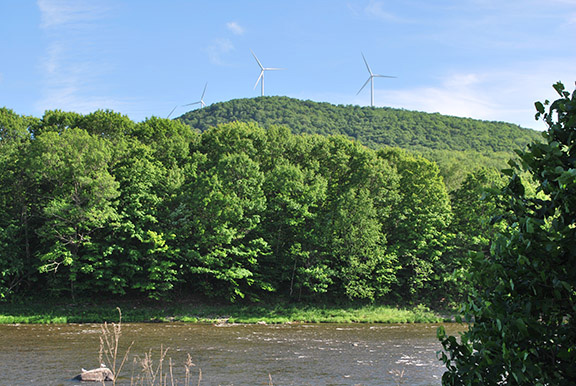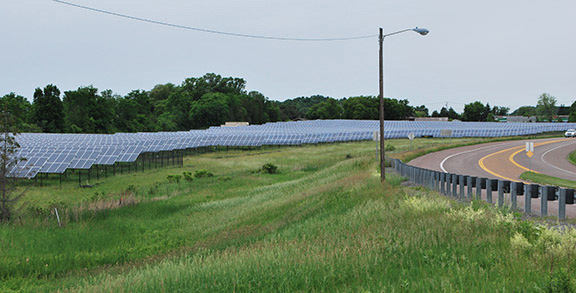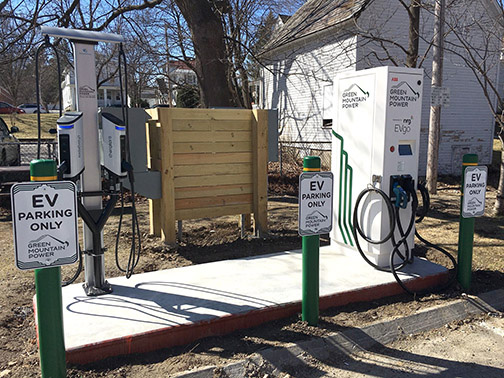| The Fraught Path to a Renewable Energy Future | ||||
|
The majority of Vermonters are in favor of renewable energy, and everyone wants to save the planet. But though everyone is concerned about the environment, not everyone agrees on how to go about weaning ourselves off fossil fuels. In 2015, the legislature set goals for when and how much of the state’s energy should be renewable: 90 percent by 2050, with intermediate goals along the way. The Department of Public Service developed a Comprehensive Energy Plan (CEP) to ensure that these goals are met. |
|||
| But to reach the 2050 target, do we build as many renewable energy projects as possible to flood the electric grid with clean energy? Or do we scale down our energy consumption, changing our habits to reduce our carbon footprints at home? People generally agree that both strategies are crucial to meeting the state’s renewable energy goals. Problems arise over priorities: what do we do first, where do we do it, and how fast do we do it. | ||||
|
The majority of Vermonters support wind and solar power: 66 percent are in favor of building wind turbines on ridgelines, a Castleton University poll says, and three-quarters of Vermonters support building more solar farms, says a poll paid for by the Renewable Energy Vermont Education Fund. Currently, fewer than half a dozen large-scale industrial wind farms are operating in Vermont, with more in the works. Despite overall support, wind farms have, in some cases, met with opposition for various reasons, including health concerns of people living nearby, concerns about damage to natural resources, and more. During the past year, renewable energy siting has been the subject of much discussion in the legislature and before the Public Service Board (PSB), the quasi-judicial entity that is in charge of approving or denying energy projects. Margaret Cheney, a member of the board, says, “We do consider local input, which often results in conditions for approval (such as screening) and has also resulted in denial, for example, if the project would have violated a clear, written community standard. However, some may feel that the process was unfair if a project was approved despite their opposition.” Annette Smith has been very critical of the reportedly complicated process by which those projects are approved. She runs Vermonters for a Clean Environment, an organization that “[has brought] environmental justice and corporate accountability to Vermont communities since 1999,” “It’s opening up the state to being a plantation for people who come in from the outside,” Smith says about the rules development projects must respect, which she says aren’t stringent enough on many levels.
The noise generated by wind farms has been a point of contention. People disagree on how much wind farm noises affect health, if at all. Robbin Clark lives 1.62 miles away from the Kingdom Community Wind farm, a 21-turbine facility along the Lowell Mountain Range, installed by Green Mountain Power (GMP) working with the Vermont Electric Cooperative. “Swooshing” is how she described the sounds coming from the wind farm. It’s a mechanical sound that gets more intense closer to the turbines, she says. She sometimes hears ringing in her ears or feels pressure, but others can’t sleep, she says. Clark is involved in testifying against industrial wind projects because of the sounds they generate. She feels that her concerns and those of others with complaints against industrial wind projects aren’t being taken seriously by the PSB. Lowell residents did vote overwhelmingly in favor of the project: on Town Meeting Day 2010, 75 percent of Lowell residents, in a 3-to-1 vote, endorsed the GMP project. They have continued to support the project in subsequent votes, with 80 percent approving. The project was, however, opposed by neighboring Albany and Craftsbury. The maximum amount of sound that wind farms are allowed to make is 45 decibels in Vermont, which is the limit the World Health Organization (WHO) recommends during the day. At night, the WHO recommends a 40-decibel limit. Forty decibels is about what a quiet residential neighborhood sounds like; 30 decibels equates to a quiet rural area. “There is no direct health effect from sound associated with wind turbine facilities,” a 2010 Vermont Department of Health report says. But there are secondary health effects, namely sleep disturbance, it goes on to say. David Blittersdorf is a private developer who built the Georgia Mountain Community Wind project. “I’ve had a home wind turbine in my backyard for 20-plus years, and the sounds that come from the wind turbines are the sound of the wind, not loud noise,” he says. “Hearing something doesn’t mean it’s noisy.” Another concern is the effect of renewable energy facilities on the local environment. “Wind has no place in Vermont,” Smith says. “The costs far outweigh any benefits.” Aside from noise pollution, she cited water quality issues, sedimentation runoff on mountains, and more. When asked about the environmental impact of renewable energy projects, Blittersdorf referred to his own Georgia Mountain project, noting that 18 acres of affected land are supplying 10 percent of Burlington’s energy, implying that there is a clear benefit. The Report on the Environmental and Land Use Impacts of Renewable Electric Generation in Vermont by the Agency of Natural Resources (ANR) notes that “utility scale wind generators typically require extensive road construction and site preparation,” requiring cutting and clearing vegetation and grading. “Robust paths” for cranes with wide-radius turns are needed to access high-elevation sites. One consequence of this is a “significant impervious surface” for both the crane path and the turbine pads, creating the potential for stormwater runoff. The report notes that Kingdom Community Wind involved 27.46 acres of new impervious surface; the First Wind Project in Sheffield has 20.75 impervious acres. Some people have expressed concerns about birds and bats being killed by wind turbines, but indicators are this effect, at least for birds, is relatively negligible. According to The State of the Birds 2014 report, housecats kill far more birds annually (in the US, 2.4 billion versus 234,000 for turbines). Other concerns are aesthetic: some people like the look of turbines; others find the sight of them marching along ridgelines disturbing—yet another incursion of humanity in the natural world. Some say this goes beyond aesthetics, imperiling Vermont’s tourist industry and compromising fragile mountaintop ecosystems. Solar panels present their own set of concerns. The same ANR report notes that many solar facilities larger than 50kW tend to be located in former agricultural fields, with farmland owners preferring to site them in unproductive wetlands, with potential negative impacts. The report notes that wetlands “provide a range of functions and values including water storage, filtration and habitat for wildlife and rare plant species, and are critical for climate adaptation and flood resilience.” Habitat fragmentation is a concern for both solar and wind projects, which can potentially reduce habitat and interfere with wildlife corridors. Martha Staskus is a principal at Vermont Environmental Research Associates (VERA), Watersbury, Vermont, and was previously a senior project developer at AllEarth Renewables, a company founded by Blittersdorf. She is also on the board of Renewable Energy Vermont, along with Blittersdorf, and manages the Georgia Mountain Community Wind project. In her role at VERA, she locates and evaluates sites for commercial wind development. “I believe it’s critically important to meet with representatives of the community and more specifically with the neighbors when you’re going to begin proposing a project,” Staskus says. The first rule of building a wind farm is to find a location where there is appropriate wind. Wind speeds increase with elevation, so most of the good sites are on ridgelines. Staskus looks for existing transmission lines, a ridgeline that’s perpendicular to the prevailing wind direction, larger parcels of land to ensure the project is as far away as possible from any neighbors, and existing open land to avoid cutting trees. “I like to leave the landscape as much as possible the way it is,” she says. Although she does look for sites, in recent years, landowners have contacted her to propose sites, she says. “The majority is driven by landowners contacting me versus me knocking on doors,” she says. Apparently, that’s what happened for the Georgia Mountain project. The farm owner called, saying he needed something to make money, and asked her to look at his land to find out what the possibilities for renewable energy production were, Staskus says. Billy Coster, the director of planning for the ANR, notes that any development will have an impact on natural resources, not just renewable energy projects. That impact is weighed against public benefit from the development in question. The CEP acknowledges that how land is used can impact many spheres. “The uses and values we impart to our lands and waters may seem to be in stark competition with each other,” it says. “But more often than not, we can find complementarities and acceptable compromises if we are up to the challenge.” “There is a range,” Coster says when asked about the impact of renewable energy projects on natural resources. Siting rules dictate how much of an impact those projects are allowed to have. But how much is too much is a matter of opinion, he says. The ANR is confident that renewable energy goals don’t threaten natural resources, but choosing the site is critical, he says: “Proactive planning at all levels will result in better outcomes.” There have been mitigation efforts. For the Kingdom Community Wind farm, which affected 135 acres, GMP procured conservation easements on over 2,800 acres, which, according to a GMP report, “includes over 1,100 acres on Lowell Mountain, and over 1,600 acres in Eden connecting important wildlife corridors between Green River Reservoir and the Lowell wildlife habitat area.”
In an effort to address some of the concerns regarding siting, the legislature introduced S.230 this year, a bill that gave local communities more say in the siting process and directed the PSB to adopt new sound limit rules and evaluation techniques. The bill passed the Senate with only three nays and passed unanimously in the House: a remarkable achievement of bipartisan support. “There was recognition across the legislature that communities needed a greater say in the energy-siting process to get more buy-in,” says Representative Kesha Ram, the vice chair of the House committee on natural resources and energy. Communities with municipal or regional plans would be able to apply for energy-compliant status. To get it, the plan would have to demonstrate that it contributes to attaining renewable energy goals. Having that status means the municipal or regional plan in question holds more weight, and the PSB would give the plan “substantial deference.” “[That] means that a land conservation measure or specific policy shall be applied in accordance with its terms unless there is a clear and convincing demonstration that other factors affecting the general good of the State outweigh the application of the measure or policy,” the bill says. “I think it’s good that there’s going to be some more local input up to a point. The law is workable as long as the PSB and everyone does their jobs…If we want to keep moving, we have to make sure that we can still permit,” says Blittersdorf, commenting on S.230. There are about 60 large wind turbines in the entire state, but to attain renewable energy goals, the state will need many more, he says But on June 6, Governor Shumlin vetoed the bill, saying in his statement that “we have made incredible progress charting a cleaner energy future that is growing jobs, putting money in Vermonters’ pockets, and helping to preserve a livable planet for future generations . . . Last-minute provisions added to S.230 would have the effect of putting the brakes on this progress and costing Vermonters jobs, two things I will not do.” A key change to S.230 was revising what some considered to be hastily enacted and stringent restrictions on the allowable noise level of large wind turbines. The original standards were set according to the noise output of one 121-foot turbine in Vergennes, generating 150kW, while large turbines range in height from 400 to 500 feet. The 10-decibel ambient sound limit was considered too strict, potentially hampering wind development. Another change in the bill was restoring a provision allotting $300,000 to train local and regional planners to comply with the new law. Shumlin’s veto forced the legislature back into session, which met on June 9. The Senate drafted a revised bill, S.260, which incorporated the governor’s requested changes, passed it, and sent it to the House for approval. House Republicans first attempted to override the veto, with House minority leader Don Turner (R-Milton) leading the effort. Ultimately, however, opponents lacked enough votes to override the veto, and the revised bill passed the House. Some members of the public and legislators have expressed concern that the changes were done quickly without public input and that this new bill (S.260) was voted on within a single day when usually three days are provided for testimony, discussion, and debate. Those concerned about wind development see the last-minute scaling back of sound limits as accommodating big wind, compromising further a bill that they believe did not give communities enough say. Some point to conflicts of interest: in a June 7, 2016, VTDigger.org commentary, Annette Smith notes that House Speaker Shap Smith, who opposed overriding the veto, is a shareholder and director of the law firm Dinse Knapp McAndrew, which represents Blittersdorf. Some are concerned that the focus on developing renewable energy projects is too great, and that some policies, namely selling renewable energy credits (RECs) out of state, means the energy projects located within Vermont communities don’t equate to taking steps toward being more environmentally friendly overall. Until 2015, Vermont was the only state that didn’t have a renewable portfolio standard (RPS), says Asa Hopkins, the director of the Planning and Energy Resources Division of the Department of Public Service. An RPS is a minimum amount of renewable energy utilities must purchase or produce as part of their portfolio. An “awkward transition period” is what Hopkins called the current state of affairs because the RPS isn’t being enforced yet so its impacts haven’t been seen. “I think we will see a shift from seeing selling a lot of those RECs out of state to retiring them,” Ram says about the future of RECs since Vermont now has an RPS. Utilities outside Vermont purchase the RECs produced by renewable energy farms in Vermont to meet their own standards. The out-of-state utility that buys RECs from Vermont does so as it continues to use nonrenewable sources of energy, suggesting that its ability to buy RECs from elsewhere isn’t incentivizing the out-of-state utility to work on renewable alternatives. It also means that local communities aren’t using renewable energy generated in local energy farms. “I actually look at the REC issue as much more of a legal issue than an actual statement on whether we have renewable power here in Vermont,” Cadwell says. “Electrons don’t care whether power is green or not. No matter where the RECs go, the power is here and being used by Vermonters.” It’s true that on the New England scale, the same amount of renewable energy appears on the grid regardless of where the REC is retired. But on the local level, that REC hasn’t been counted toward Vermont’s own renewable energy goals. The attorney general recently warned Vermont utilities not to market their energy as renewable if they are selling their RECs. GMP, for instance, sells some of its RECs but not all. Forty-two percent of the utility’s portfolio is renewable, and 18 percent of its energy portfolio is both renewable and sold as RECs. “New projects will be counted towards the goals,” Hopkins says.
Attaining that 90 percent goal by 2050 is feasible, but it won’t be easy. “We need a continued steady pace of development in Vermont over the next 15 years,” Hopkins says. The distillates that provide 48 percent of the state’s energy are used mainly in a residential setting, for heating for example. According to a 2013 NMR Group report submitted to the Department of Public Service, only 12 percent of Vermonters use wood, a renewable resource, as their primary source to heat their homes, compared to 87 percent who use either fuel oil, propane, or natural gas. Encouraging the use of heat pumps as a replacement for heating oil or natural gas is one option to reduce the use of fossil fuels, and electrifying more vehicles is another. “We work with homes and businesses that want to radically transform the way they consume energy,” says Mary Powell, president and CEO of GMP. “Our approach is to meet customers where they are rather than mandate how they should think and feel.” One hundred and twenty GMP customers went all out, optimizing their entire homes or businesses to be more energy efficient and use only clean energy, and one thousand GMP customers use heat pumps to heat their homes, she says. Increasing the amount of renewable electricity on the grid and increasing the use of electricity as an energy source will contribute to moving away from burning fossil fuels. According to Blittersdorf, the entire approach to energy consumption has to change. “To hit the numbers, we have to decrease energy use by three-quarters,” Blittersdorf says. “So far what we’ve done with efficiency is maybe 10 percent. There’s a massive change we have to do.” He spoke about increased public transit and encouraging folks to move into towns and cities, allowing resources to be pooled, and easing up on the car-centric lifestyle. To Smith, the solution is to create sustainable microcosms by using solar power, batteries to store power, and a gas generator for emergencies. She is a big fan of using solar in the existing landscape. That’s not feasible for wind towers, Blittersdorf says. He points out that four industrial wind towers equate to about 15,000 homeowner turbines; not only do the small-scale projects have a larger environmental impact, but the cost is five times higher. “Small wind doesn’t replace large wind,” he says. Hopkins is optimistic about reaching 90 percent renewables by 2050. The CEP takes a planning-heavy approach and looks at the objectives in multiple sectors, not only in terms of energy. “It’s a big long-term thing,” he says. The CEP recommends action steps to increase renewable energy usage at state facilities, reduce transportation-related energy use and emissions, continue and expand solar energy initiatives, and more. It is available online at publicservice.vermont.gov/publications-resources/publications/energy_plan/2015_plan.
|
||||
|
Nathalie Gagnon-Joseph is a journalist working in Vermont’s Northeast Kingdom. Kate Mueller is the Editor of Vermont Woman newspaper.
|
|||



